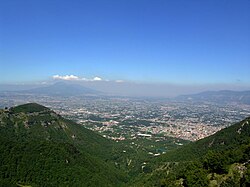Agro Nocerino-Sarnese Agro Sarnese-Nocerino | |
|---|---|
geographical region | |
 | |
 | |
| Coordinates: 40°45′N14°33′E / 40.75°N 14.55°E | |
| Country | Italy |
| Region | Campania |
| Province | |
| Comuni | |
The Agro Nocerino-Sarnese or Agro Sarnese-Nocerino [1] is a geographical region of the Province of Salerno, in Campania in southern Italy; the river Sarno flows through it. It is a low-lying area bounded to the south by the Monti Lattari, to the east and north-east by the Monti Picentini and to the west by the plain of Vesuvius. It consists of sixteen comuni: Angri, Bracigliano, Castel San Giorgio, Corbara, Nocera Inferiore, Nocera Superiore, Pagani, Roccapiemonte, San Marzano sul Sarno, San Valentino Torio, Santa Maria la Carità, Sant'Antonio Abate, Sant'Egidio del Monte Albino, Sarno, Scafati and Siano. All are in the province of Salerno except Santa Maria la Carità and Sant'Antonio Abate, which are in the province of Naples. [2]